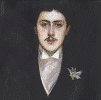Modern Languages and Literatures, Department of
Date of this Version
March 2001
Abstract
The following was presented as a lecture in conjunction with the exhibit of 18th-century European fans, held at the McMullen Art Museum of Boston College, September, 2000. The author is Professor of French at the University of Nebraska. He is the author of books and articles on French literature, and the editor of Nineteenth- Century French Studies.
To have 19th-century French poetry breeze into this exhibit of beautifully crafted fans from the 18th century should be viewed as a complementary and friendly action. Indeed, the exhibition title, "Hand-held Delight," is especially apposite for our topic today, for the poet in question, Stéphane Mallarmé (1842- 1898) took particular delight in the marvelous object that is the fan, its characteristic deployment, fold by fold, recalling for him that most cherished of objects, the book, that reveals its meanings page by page. And, since, as the exhibition here beautifully illustrates, a fan is rarely just a fan, its mechanism provided the poet with an elegant metaphor for the gradual emergence of any image, even the lifting fog in the Belgian city of Bruges that slowly exposed the old buildings, "pli selon pli." While rarely "just a fan," a fan often is, however, a fan, and what is most pertinent for us today, is that Mallarmé wrote poems on fans, and I mean that in both senses: poems about fans, and also poems written on that wonderllly suggestive surface. He also decorated them. So, when we speak of Mallarmé's fan poems, we are referring to a rather unique artistic genre comprised of literary, painterly and rather specific cultural elements, associated with an intimate setting or space that was at once feminine and artistic.
What I propose we do today is to follow Mallarme along a meandering path through these objects and the topics they evoke (to this reader at least), that we take a kind of visite guidée through the new but temporary Mallarmé Wing of the McMullen Art Museum. Mallarmé's interest in fans was part of a larger network of associations, dating from the 1860s and '70s, that included ladies' apparel and accessories, and collectible curios. It culminated in the 1880s and '90s at the height of the Japanese influence on French sensibilities, both artistic and mundane, known as japonisme. This last topic is familiar to many of us in the context of French painting fiom the mid 1870s onward, but it has been little explored in any detail with respect to the poetry of the same period.


Comments
Published in FANA Quarterly, volume XIX, no. 4 (Spring 2001), pp. 6–28. Published by the Fan Association of North America; used by permission. Copyright © 2001 Marshall Olds.
http://www.fanassociation.org/